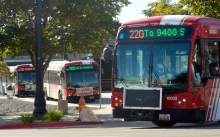This is an archived article that was published on sltrib.com in 2016, and information in the article may be outdated. It is provided only for personal research purposes and may not be reprinted.
The Utah Supreme Court is allowing the Utah Transit Authority to continue work on a controversial $190 million "bus rapid transit," or BRT, project in Provo and Orem while it hears a case that may allow voters in the 2017 election to thwart parts or all of it.
Justices on Wednesday rejected motions from grass-roots groups seeking to stop construction while the court considers their lawsuit seeking to allow a vote on overturning street leases by Provo and Orem for that project.
They argued that UTA is trying to speed work so if voters are allowed to cast ballots on the BRT project, they would be less willing to stop it because of the large amounts of money already spent.
Associate Chief Justice Thomas R. Lee issued an order saying the court finds "the motions have failed to present allegations sufficient to demonstrate an emergency warranting such injunctions."
The court is scheduled to hear arguments Oct. 14 on the main case.
If it allows a vote to overturn the street leases, the grass-roots groups say, it could stop the project by putting federal grants in jeopardy. UTA has said it would not halt the project, but it could stop some enhancements the cities had negotiated.
The Utah Constitution allows using referendums to overturn ordinances passed by city councils — and groups in Provo and Orem collected enough signatures to put on the ballot the BRT leases approved by the cities' councils.
However, the cities rejected the petitions based on the contention that the leases are administrative actions not subject to referendum.
The groups appealed directly to the Supreme Court, hoping it will allow a vote in the November 2017 elections.
In July, the UTA board approved launching the controversial project immediately by gambling up to $23.8 million in advance funding that it says federal and county governments will almost surely reimburse later — but the grass-roots groups say that funding could be threatened by their proposed referendums.
UTA countered that launching now — before expected federal grants have been awarded and expected county bonds are issued — could save $3 million to $5 million in construction costs.
"We knew the injunction was going to be a long shot, but we thought it was worth a try," said Diane Christensen, one of the people suing the cities. "We're not surprised we lost. This isn't a huge setback."
Provo Deputy Mayor Corey Norman, a spokesman for UTA and partners building the BRT project, said, "We're looking at turning the page now that the injunction has been denied, and it's our hope we can focus our energy on what we anticipate will be a very incredible project."
Construction has begun, he said, and is most noticeable on University Parkway — where the Utah Department of Transportation also is working as part of the project.
The BRT would use extra-long buses and have bus-only lanes for about half their 10.5-mile route. Buses may receive priority at traffic signals and would arrive about every six minutes at peak times.
The route would include Utah Valley University, Brigham Young University, downtown Provo and the Provo Towne Centre mall.



